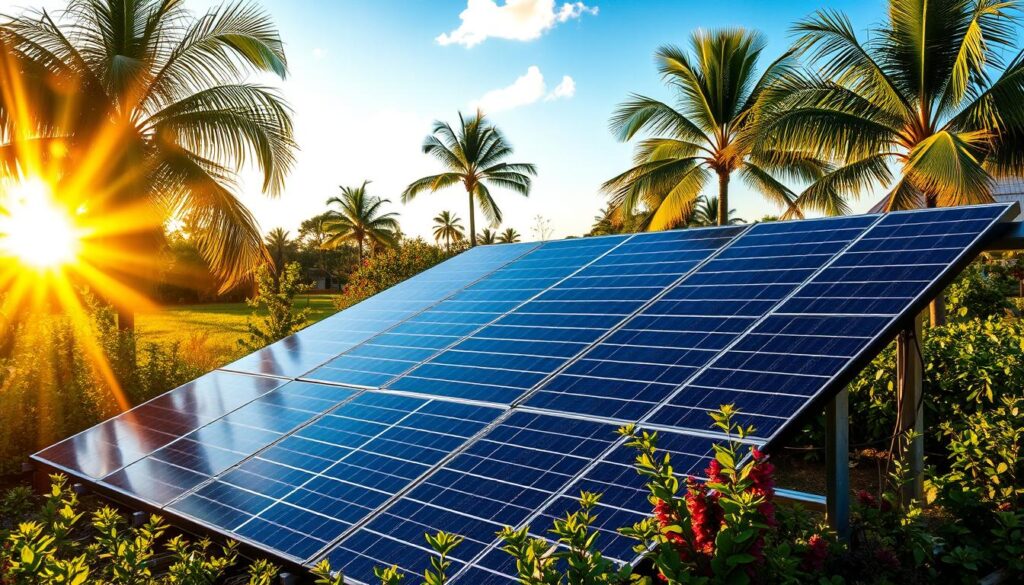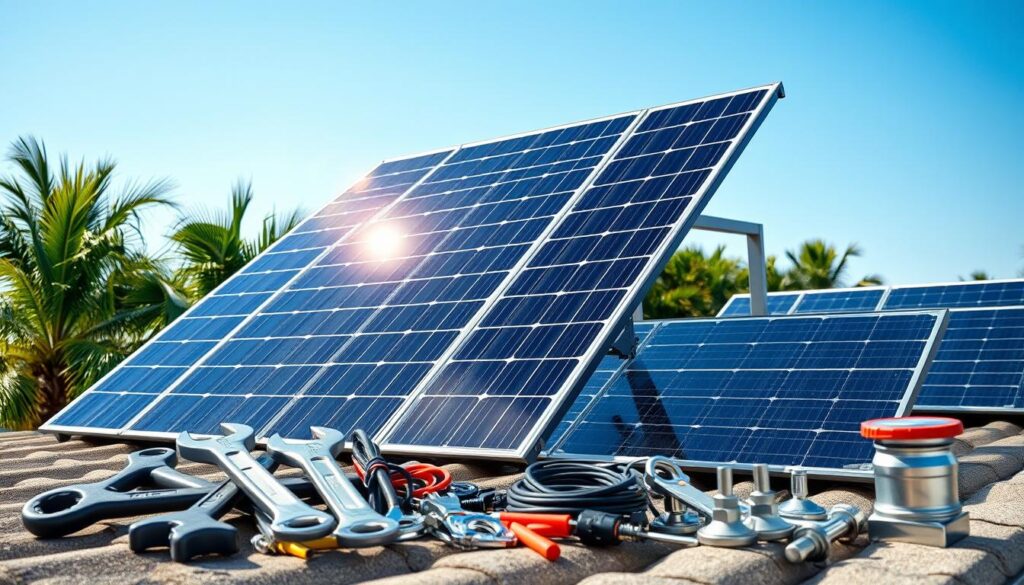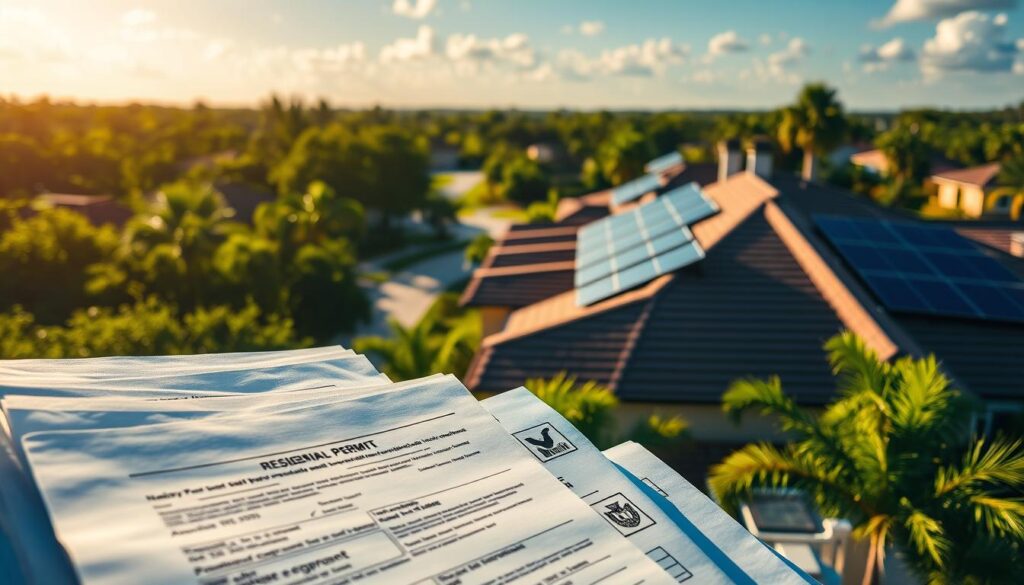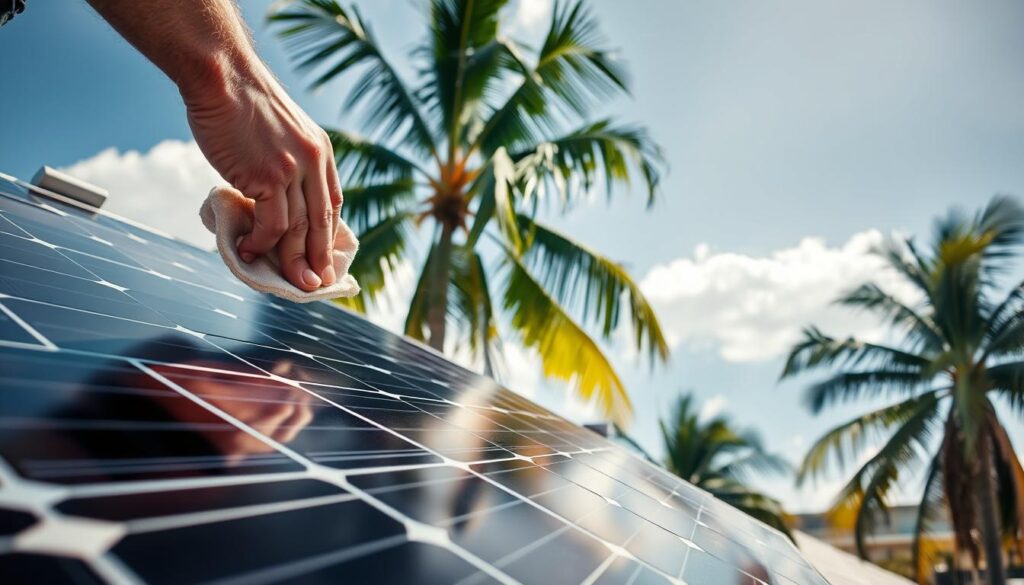Florida’s sunny climate makes it a prime location for solar energy, with average installation costs between $12,500 and $17,000. Many homeowners ask, “can I install my own solar panels in florida?” while exploring DIY solar panel installation. This guide breaks down the basics, from incentives to practical steps.
Florida aims to boost solar adoption by 2030, backed by programs like the Florida Renewable Energy Tax Incentives. Homeowners can cut costs using tax credits, rebates, or financing. DIY projects may save money, but understanding permits and safety is key. Solar Energy World, a 15-year industry leader, highlights the importance of research before starting.
Key Takeaways
- Florida’s average solar installation costs range from $12,500 to $17,000.
- DIY solar panel installation could save 20-30% on energy bills with proper planning.
- Florida offers tax credits like the 26% ITC (2020-2022) and 22% (2023).
- South-facing roofs with 15-40 degree slopes optimize panel performance.
- DIY projects must comply with local codes and HOA rules in solar-friendly areas.
Can I Install My Own Solar Panels in Florida?
Installing solar panels yourself in Florida is legally possible, but requires understanding Florida solar panel regulations. Homeowners must comply with local building codes while exercising their rights under state law. Here’s what to know before starting.
Understanding Homeowner Rights
Florida Statute 489.103(7)(a) grants homeowners the right to act as their own contractors for their primary residence. This means you can install solar systems without a contractor license, as long as you oversee all non-licensed work. A key legal provision states:
“Owners of property when acting as their own contractor and providing direct, onsite supervision themselves of all work not performed by licensed contractors…”
This exemption applies only to owner-occupied homes. Commercial properties or rentals require licensed professionals.
Local Regulations and Permits
All installations must follow solar panel permits in Florida requirements. Steps typically include:
- Applying for electrical and building permits
- Submitting system design schematics
- Passing final inspections
Some counties use online portals to simplify permit applications. Visit your city’s official website for local requirements. Always confirm interpretations with local AHJs to avoid disputes.
Insurance Considerations
DIY installations might affect homeowner’s insurance policies. Some insurers require licensed installation for coverage. Contact your provider to verify if your policy covers self-installed systems. Updating your policy to include solar equipment is often advised.
Benefits of DIY Solar Panel Installation
For Florida homeowners exploring home solar installation guide options, the benefits of DIY solar panel installation include tangible savings and empowerment. While professional help is sometimes needed, taking charge of your energy future can lead to long-term rewards.

Cost Savings on Installation
Going solo can slash upfront expenses. Labor makes up 10% of total costs, per the U.S. Department of Energy. In Florida, a typical $20,000 system might save $2,000-$6,000 by DIY. But note: some rebates require licensed installers. Here’s the breakdown:
| Aspect | DIY | Professional |
|---|---|---|
| Upfront Savings | 20-30% lower | Full cost |
| Warranty Eligibility | Risk of voided terms | Full coverage |
Increased Energy Independence
By generating power onsite, you reduce grid reliance. Florida’s frequent storms make this vital—solar systems can keep essentials running during outages. Even small setups cut utility bills by 10-25%, shielding against rate hikes.
Environmental Impact
Switching to solar reduces CO2 emissions by 3-5 tons yearly. Florida’s 5,000 MW of installed capacity (SEIA 2023) shows collective progress. Properly installed systems boost efficiency by 25%, lowering fossil fuel use. Every rooftop helps meet state clean energy goals.
While DIY solar offers clear advantages, research local codes and safety guidelines. A smart start with a home solar installation guide ensures you balance savings with safety.
Assessing Your Home’s Suitability for Solar
Before starting DIY solar panel installation, evaluate your property’s potential. This home solar installation guide highlights three key factors to ensure your roof can support a solar system effectively.
“Optimal solar system performance requires uninterrupted exposure to the sun’s rays throughout a significant portion of the day,” states the California Energy Commission.
Rooftop Direction and Structure
South-facing roofs capture maximum sunlight in Florida. Slopes between 15-40 degrees work best. Check roof age—panels last 25+ years, so a roof needing repairs soon could complicate installation. Use a ladder inspection or drone to spot cracks or damage.
- South-facing roofs maximize energy yield
- Roof age under 10 years is ideal
- Steep or flat roofs may require structural checks
Shading Analysis
Tree branches, chimneys, or neighboring buildings blocking sunlight reduce output. Shade during peak hours (10 a.m. to 2 p.m.) lowers efficiency. Use apps like PV Watts or hire a professional to map shadows seasonally.
- Trim trees obstructing southern exposure
- Note seasonal changes (e.g., leafless trees in winter)
- Partial shading can reduce output by 20% or more
Space Calculation
Rooftop space determines system size. A 5kW system needs 500-2,000 sq ft. Use this table to estimate capacity:
| System Size (kW) | Rooftop Space Needed (sq ft) |
|---|---|
| 3 kW | 300–1,200 |
| 5 kW | 500–2,000 |
| 10 kW | 1,000–4,000 |
Use your utility bills to match energy needs with system size. Multiply your home’s average daily usage (kWh) by 30% (efficiency factor) to estimate required panels.
Pro tip: Shingle roofs with 15+ years left often work best. Start with a free online assessment tool like EnergySage to pre-screen your property.
Choosing the Right Solar Panels

When DIY solar panel installation in Florida, selecting the right panels ensures long-term efficiency and savings. Florida’s sunny climate, with 237 days of annual sunlight, demands panels that perform in heat and humidity. Here’s how to pick the best option for your project.
Types of Solar Panels Available
- Monocrystalline: High efficiency (17-22%) but pricier, ideal for smaller rooftops.
- Polycrystalline: Cost-effective, 15-17% efficiency, better in hot climates like Florida.
- Thin-Film: Lightweight and flexible, but needs more space due to lower efficiency (11-13%).
Key Factors to Evaluate
Check temperature coefficients to avoid efficiency drops in Florida’s heat. Look for panels with warranties guaranteeing at least 80% output after 25 years. Durability against storms and humidity is critical. Pair panels with inverters rated for your system size—like a 7.15kW setup common in residential projects.
Trusted Brands and Manufacturers
Choose brands with strong customer support for self-install solar panels in Florida. Top picks include:
- SunPower: High efficiency, 25-year warranty.
- LG: Neat design, proven performance in humid climates.
- Canadian Solar: Cost-effective polycrystalline options.
Read reviews and compare warranties to align with your energy needs and budget.
Understanding Solar Panel Installation Processes
Solar panel installation requires careful planning and execution. Follow these solar panel installation steps to ensure a safe and effective setup. Start by assessing your roof’s condition and orientation. Most systems take 1–2 days to install once permits are secured. Professional installers often complete the electrical setup and system testing in this timeframe.
Key solar panel installation tips include checking local codes and securing permits. Begin by mounting racking systems, securing panels, and wiring electrical components. Always hire a certified electrician to inspect the system before connecting it to your home’s grid.
Tools and Equipment:
- Racking systems and torque drivers
- Inverters and voltage testers
- Roof brackets and safety harnesses
- Wire management kits and conduit supplies
Safety Precautions: Wear non-conductive gloves and secure ladders on uneven surfaces. Never work during rain or high winds. Always de-energize circuits before handling wiring. Partner with a helper to avoid falls or electrical hazards. Professional installers use certified gear to minimize risks like fire or system malfunctions.
Skipping proper safety measures risks violating local codes. Florida’s permitting process often requires a licensed electrician’s approval before finalizing the system. Prioritize training or consult experts for high-voltage tasks to ensure long-term performance and safety.
Financial Incentives and Rebates in Florida
Going solar in Florida comes with financial rewards. Homeowners asking can I install my own solar panels in florida can tap into federal and state programs to reduce costs. Before starting, check solar panel permits in Florida to qualify for tax breaks and rebates.

Take advantage of the Solar Investment Tax Credit (ITC), which covers up to 30% of installation costs until 2032. For example:
A $30,000 system in 2025 earns a $9,000 tax credit. Unused credits can roll over for up to 5 years.
- 2022–2032: 30% credit for systems
- 2033: Drops to 26%, then 22% in 2034
- Covers panels, inverters, and installation labor
Florida offers property tax exemptions for solar systems and waives sales tax on equipment. All four major utilities—FPL, Duke Energy, TECO, and Gulf Power—provide 1:1 net metering, turning excess energy into bill credits. Some cooperatives offer net billing with reduced rates.
Spread costs with options like:
- $0 down solar loans from providers
- Home equity loans (often at lower rates)
- Leasing programs with flexible payment plans
These options pair well with tax credits, lowering upfront costs. Use the NREL’s PVWatts tool to estimate savings and system performance for your location.
Maintenance and Monitoring of Solar Panels
Regular upkeep is key to getting the most from your self-install solar panels in Florida. Even with proper solar panel installation tips, weather and time can affect performance. Florida’s humid climate and storms mean extra care is needed to keep systems running smoothly.

Regular maintenance can help solar batteries last at least ten years with optimal energy storage.
Regular Maintenance Tasks
- Check roof mounts and seals twice yearly to prevent leaks caused by wind or humidity.
- Clean panels quarterly—use a soft brush and water to remove pollen buildup and debris after storms.
- Inspect wiring and inverters annually. Loose connections or corrosion can cut energy output by up to 20%.
Monitoring Energy Production
Track output with tools like the Generac PWRview system, which shows real-time data. Set alerts for drops in energy generation. Florida Power Services notes that 60% of service calls stem from undetected efficiency losses.
Troubleshooting Common Issues
Spot issues early:
- Inverter errors: Check error codes online or contact a technician. Most fixes take under an hour.
- Low output: Shading or loose wiring often cause dips. Use a voltage meter to test connections.
- Battery problems: Clean terminals and ensure batteries are stored in dry, ventilated areas.
If issues persist, Florida Power Services covers repairs within 50 miles of Tampa. Remember: power surges or weather damage aren’t covered under warranties—always document incidents.
Finding Professional Help When Needed
Professional guidance ensures your solar project aligns with Florida solar panel regulations and avoids costly mistakes. A home solar installation guide can’t replace expertise when facing complex tasks. Here’s how to navigate this crucial step.
“The best way to install solar is through qualified professionals who work with high-quality panels.”
Look for these credentials:
| Credential | Requirement | Why It Matters |
|---|---|---|
| NABCEP Certification | Industry certification | Guarantees technical expertise |
| Florida License | State-issued permit | Required by Florida solar panel regulations |
| Insurance | Liability and workers’ comp | Protects against job-related risks |
| Reviews | 20+ verified customer reviews | Shows reliability and experience |
Average 5kW system costs $15,254 before tax credits. Federal rebates cut this to ~$10,678. Ask installers about:
- Payment plans for upfront costs
- Guarantees for workmanship and equipment
- Cost savings from bulk panel purchases
Always compare at least three quotes and verify licenses through the Florida Solar Energy Industries Association (FSEIA).
Conclusion: Making the Right Choice for Your Home
Asking “can I install my own solar panels in florida” is just the first step. Whether you choose DIY or professional help, solar energy unlocks savings and sustainability. Florida’s sunny climate and incentives make it ideal for homeowners ready to cut energy costs and boost home value.
Weighing DIY vs. Professional Installation
DIY solar panel installation tips include checking local permits and roof suitability. Professionals ensure compliance with Florida’s regulations and warranty protections. Compare upfront costs: a 5kW system averages $11,000 after tax credits, but hiring pros adds labor fees. Factor in time—DIY takes weeks, while pros finish faster. Warranty coverage and long-term performance also matter, as panels last 25+ years.
Final Thoughts on Going Solar in Florida
Florida’s 4 kWh/m² daily sunlight and 6 hours of peak sun make solar highly effective. The federal 26% tax credit plus state rebates can slash costs by up to 50%. Homes with solar see 10-25% higher resale value, and systems like Brennan’s 10kW setup slash bills by 60%. Even with cloudy days, modern panels maintain efficiency. Miami Dolphins’ stadium proves large-scale success—your home can too. Start by calculating your energy needs and explore zero-down financing. Solar isn’t just a trend; it’s a smart move for Florida’s sunny future.
